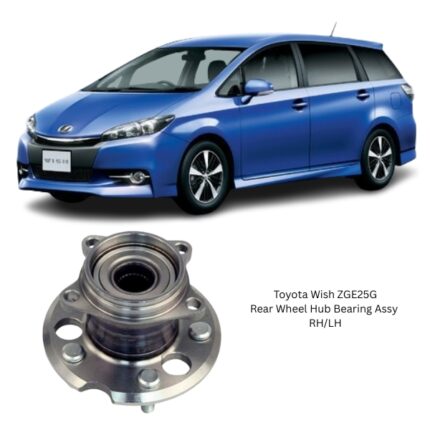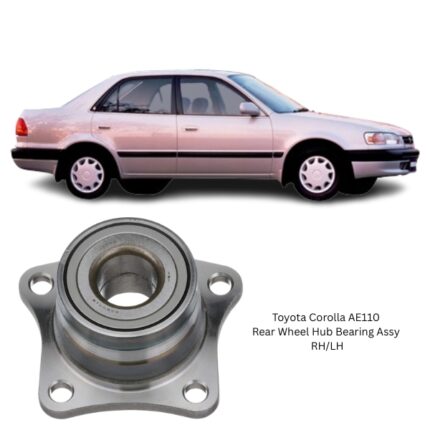-7%
Get Nissan Qashqai J10E Rear Wheel Hub Bearing Assy RH/LH 43202-JG200 in Kenya
The Rear Wheel Hub Bearing Assembly RH/LH is a precision-engineered component that forms a critical part of a vehicle’s rear suspension and wheel system. Its primary function is to house and support the wheel bearings, providing a smooth and stable rotation of the rear wheels while maintaining alignment with the suspension geometry and braking system.
Combining the hub and bearing into a single pre-assembled unit, this component ensures enhanced structural integrity, reduced installation time, and improved load distribution. Designed for both the right-hand (RH) and left-hand (LH) rear wheel positions, the assembly is symmetrical and interchangeable when appropriate, depending on the specific axle and suspension design.
Core Function and Role in Vehicle Operation
The rear wheel hub bearing assembly serves several essential functions:
-
Bearing Support: It provides a housing for the wheel bearing, allowing the wheel to rotate freely with minimal friction and vibration.
-
Load Transfer: It supports the vehicle’s weight and absorbs both vertical and lateral loads from acceleration, braking, and cornering.
-
Wheel Mounting Surface: The hub features a flange with pre-drilled holes or studs onto which the wheel is mounted and secured.
-
Brake System Integration: It often includes provisions for mounting brake rotors or drums and, in some designs, includes an integrated tone ring or encoder for ABS sensors.
The rear hub bearing assembly is a load-bearing component that must operate reliably under varying temperatures, speeds, and road conditions. Failure or degradation can result in wheel play, noise, handling instability, or brake system inefficiencies.
Construction and Design
A modern rear hub bearing assembly is designed for strength, durability, and precision. The main structural and functional elements include:
1. Wheel Bearing
-
Usually a double-row angular contact or tapered roller bearing design, sealed and lubricated for life.
-
Positioned at the center of the hub, it ensures smooth rotation while supporting radial and axial loads.
-
Enclosed with high-temperature grease and protected with internal seals to prevent contamination.
2. Hub Flange
-
Machined to tight tolerances to ensure concentric rotation of the wheel.
-
Serves as the mounting surface for the wheel rim and brake components.
-
Constructed from forged steel or cast iron for strength and rigidity.
3. Wheel Studs or Bolt Holes
-
Fixed onto the flange, allowing the wheel to be mounted using lug nuts or bolts.
-
Positioned evenly for load distribution and balance.
4. ABS Sensor Ring or Encoder (Optional)
-
Many rear hub assemblies include an integrated tone ring or magnetic encoder for anti-lock braking system (ABS) feedback.
-
Located inside or behind the bearing seals, this component interacts with a wheel speed sensor to monitor wheel rotation.
5. Mounting Face or Bracket
-
The rear of the assembly includes a machined surface or ears for secure bolting to the rear knuckle or trailing arm.
-
Engineered for accurate alignment with the axle shaft and suspension geometry.
Materials and Manufacturing
The durability and performance of the rear wheel hub bearing assembly are deeply tied to its material composition and manufacturing precision. Common materials include:
-
High-Carbon Alloy Steel: Used in bearing races and rollers for hardness and fatigue resistance.
-
Forged or Cast Steel for Hubs: Offers excellent strength-to-weight ratio and resistance to deformation under load.
-
Seals and Encoders: Made from high-durability polymers or elastomers resistant to oil, water, dirt, and road chemicals.
-
Grease: A high-temperature, long-life lubricant designed to withstand continuous rotation and extreme conditions.
All surfaces are precisely machined to meet strict tolerances that ensure smooth bearing operation and prevent imbalance or eccentric motion.
Operational Characteristics
The rear wheel hub bearing assembly is subjected to high rotational forces and must endure a variety of conditions, including:
-
Radial and Axial Loads: From vehicle weight, road bumps, and lateral forces during cornering.
-
Thermal Expansion: Due to heat generated from bearing friction and braking systems.
-
Contaminant Resistance: Operation in dusty, wet, or salt-laden environments necessitates excellent sealing performance.
-
High-Speed Rotation: Must maintain concentric rotation to avoid vibrations and noise.
To perform reliably under these conditions, the assembly undergoes rigorous quality testing for concentricity, torque resistance, wear performance, and seal integrity.
Common Symptoms of Wear or Failure
A worn or failing rear hub bearing assembly can lead to noticeable symptoms, including:
-
Grinding or humming noise from the rear wheel area during driving.
-
Play or looseness when the wheel is rocked by hand.
-
Uneven tire wear due to misalignment caused by bearing wear.
-
ABS warning light or malfunction if the encoder ring is damaged.
-
Increased braking distance or instability during braking due to movement in the hub.
Timely inspection and replacement are necessary to ensure road safety and vehicle reliability.
Installation Considerations
Proper installation of the rear wheel hub bearing assembly is critical to its performance and lifespan. Key considerations include:
-
Surface Preparation: Clean the mounting surfaces of rust, debris, or old sealant to ensure flush contact.
-
Torque Specifications: Use manufacturer-recommended torque values for all bolts and fasteners to avoid deformation or imbalance.
-
ABS Sensor Alignment: If equipped, ensure the ABS sensor is correctly aligned with the encoder ring for accurate readings.
-
Axle Shaft Fitment: In independent suspension designs, align the axle shaft splines carefully with the hub’s internal bore.
-
Rechecking after Road Test: Confirm that there is no excessive noise, wheel play, or ABS error after installation.
Using the correct tools—such as a torque wrench, bearing press (if needed), and hub puller—is essential to avoid damage during the removal or fitting process.
Maintenance and Service Life
Rear hub bearing assemblies are typically designed to be maintenance-free, with sealed bearings that require no lubrication over their service life. However, their lifespan can be influenced by:
-
Driving conditions (e.g., frequent potholes, gravel roads)
-
Load and towing demands
-
Wheel alignment and suspension condition
-
Proper torque application during wheel installation
Regular vehicle inspection schedules should include checking for bearing noise and wheel play to detect issues early.
Follow us on Facebook for more parts.





Reviews
Clear filtersThere are no reviews yet.